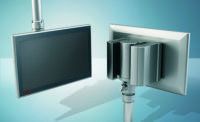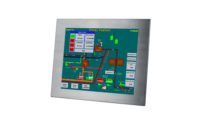Most of us are familiar with capacitive touch screen technology from using it on our smartphones and tablet computers. It’s fast, responsive, dynamic and a world away from the functionality of the older resistive touch screens still being used in the cold food and beverage industry.
However, it’s also common knowledge that typical smartphones and tablets don’t work well under certain conditions such as cold and wet environments, or when wearing gloves. Is there some way that capacitive technology can be made to function reliably in these difficult environments, so that the industry can take advantage of its superior user experience?
The answer is yes.
By uniquely integrating projected capacitive touch (PCT) technology in a rugged aluminum body, and by using complex algorithms to monitor the usage of the PCT, it is perfectly possible to upgrade computer terminals used in refrigerated and freezer environments to a rugged version of capacitive touch that offers a rich user experience while maintaining unparalleled durability.
For starters, the PCT technique means the capacitive touch sensor can be placed behind a layer of strong, chemically toughened glass and still work perfectly. The glass is thick enough to provide ruggedization, but thin enough not to add too much weight to the unit or introduce parallax error. This means the screens can be made very rugged, resistant to humidity and frost and rated for use down to very cold temperatures, such as those in freezer units. It also makes the screens completely scratch proof and virtually unbreakable, reducing downtime due to breakages and the costs associated with maintenance.
The chemically toughened glass with the touch sensors under it gives very good protection and greater freedom when designing the computer front. For example, the protective glass of the touch display can extend all the way to the edges of the screen, which means the front of the computer can be completely flush – no cavities for food or germs to collect, so it can be easily cleaned and disinfected when required. The flush front also allows for the same gestures and user interface as in a modern consumer device.
With continued advances in electronics and software design, advanced algorithms can also be implemented in the touch screen firmware to fully control usage and dynamically adapt to different conditions to detect “false touches.” This means it can recognize when something conductive other than the user’s finger comes near the screen, such as water droplets if it’s in a wet environment or the palm of the hand. Special ruggedized PCT screens are suitable for use in areas with humidity, rain or condensation in the air. With the cold storage supply chain in mind, the advanced firmware also allows for using the ruggedized PCT screens with most types of gloves (all except the thickest chopper mittens). This is down to an added level of sensitivity that the screens can provide. This functionality in combination with a custom-designed virtual keyboard on the touch screen that shows only relevant buttons and makes them bigger so they are easier to press with gloves on, also allows for quicker and more accurate data entry.
Capacitive touch technology also offers one big thing that resistive can’t, and that’s multi-touch, the ability to register more than one touch at the same time. In practice, this means the screens enable familiar gestures, such as pinch-to-zoom, drag and drop, flick to scroll and more. Combined with speedy responsiveness, this makes for a completely different user experience to resistive technology. In fact, being able to use capacitive touch in the work environment often delights workers; it’s similar to the high-end user experience they get from the tablet PCs they have at home, helping them work faster and without the frustrations of screen areas or buttons that have broken due to regular use.
The result of all these technology advances are rugged capacitive touch screen computers that offer the functionality and responsiveness of consumer tablet PCs, combined with the ability to operate in cold, wet conditions, combined with never-before-seen levels of ruggedness and durability. This can increase a workforce’s productivity and efficiency, streamline processes and significantly reduce downtime and maintenance costs. Challenging environments such as the cold food and beverage industry can now take advantage of this state-of-the-art technology.



